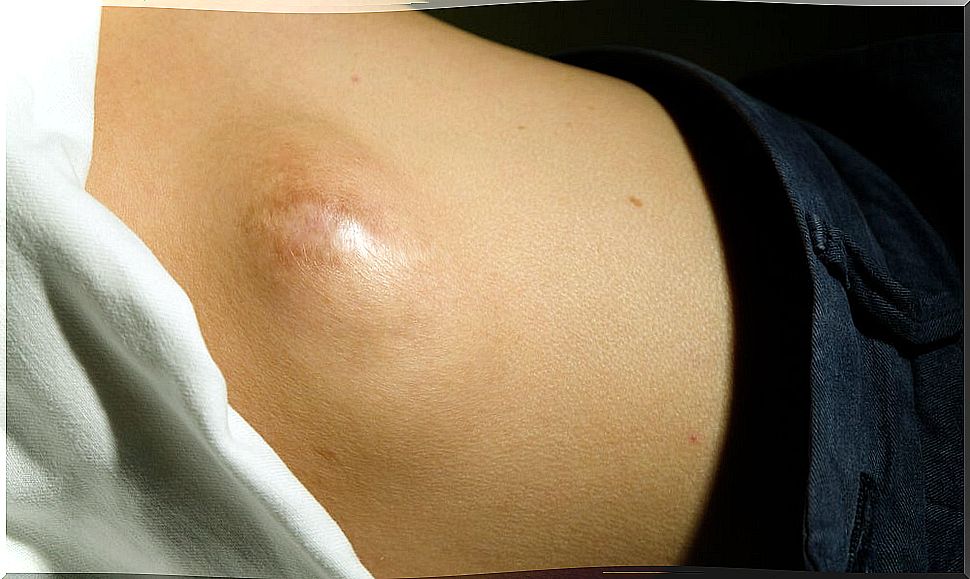What Is A Lipoma?
A lipoma is a lump made of fat cells. Often, it is located between the subcutaneous layer or tissue and the components of the muscles. It is a benign tumor, that is, it is harmless to the patient.
Unlike malignant or cancerous tumors, lipomas stop growing at a certain point and maintain their size. In this sense, it should be noted that, in general terms, its growth is very slow, and its duration may vary from one patient to another. Other examples of benign tumors are moles.
On the other hand, there are clinical cases in which a lipoma can lead to the presence of cancer. However, this alteration occurs very infrequently among subjects. Lipomas generally develop on the back, neck, and shoulders. They can also appear in other body regions. Subjects may have more than one simple lipoma.
According to data from various clinical studies, women tend to have only simple lipomas, while men are more likely to develop several groups of lipomas.
At the moment, the cause of this decompensation is unknown.
What are the most common symptoms of a lipoma?
Patients with this alteration usually develop a series of characteristic signs. For example, among the most common symptoms of a lipoma we can mention:
- Pain of variable intensity. The patient may feel discomfort if the lipoma presses on a nerve ending or compresses nearby blood vessels.
- Small size. As a general rule, they do not reach 5 centimeters in length, but there are exceptions.
- It has mobility, that is, if it is gently pressed it is able to move slightly. In addition, it has a pasty and smooth texture.
What are the possible causes of a lipoma?

Currently, specialists do not know the exact cause that causes the development of lipomas. However, recent research has been able to identify a number of risk factors. That is, a set of medical conditions that increase the chances of presenting a disorder. Among them we can include, for example:
- Genetic heritage. Patients with lipomas usually have a family history (relatives with the same problem). Therefore, experts believe that the alteration has a genetic component.
- Lifestyle of the patient. Lipomas appear more frequently in overweight or obese subjects. Also, most patients are between 40 and 60 years old.
- Certain pathologies. In particular, the following diseases:
- Painful adiposis. It is a disorder that causes numerous lipomas that cause discomfort to the patient.
- Lipomatosis
- Gardner syndrome.
- Cowden syndrome.
How is the diagnosis of a lipoma made?

Generally, the medical team performs a series of medical tests to identify the condition. In this way, you can also rule out other disorders with similar characteristics. Either way, the most common diagnostic procedures are:
- Physical exam. The specialist will check the fat lump and its properties. Likewise, a check of the patient’s medical history and background will be carried out.
- Lipoma biopsy. In this test, a small amount of tissue is removed and analyzed in a specialized laboratory.
- Obtaining internal images. Thus, all the characteristics of the lipoma can be verified. As a general rule, techniques such as computerized axial tomography, ultrasound or magnetic resonance imaging are used.
There is a form of lipoma that does form a cancerous or malignant tumor called liposarcoma . Thanks to the aforementioned medical procedures, the medical team can ensure that it is a benign and harmless tumor.
Which is the treatment?
Generally, the patient’s lipoma does not cause pain or discomfort. Therefore, no specific treatment is necessary. However, the lump may begin to grow abnormally or cause discomfort in the subject. In that case, the most common treatment methods are as follows:
- Surgical intervention. In surgery, the lump is removed and in most cases it is prevented from reappearing in the future.
- Liposuction The lipoma is punctured and absorbed completely with the help of a syringe and needle.
- Steroid injection to reduce the size of the lipoma. On the other hand, it is not capable of completely eliminating the alteration.







